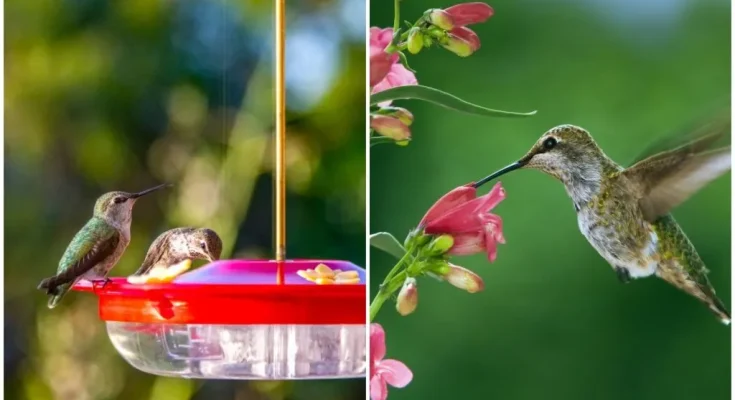I’m just warning you right now if you clicked on this to read, and you’re serious about attracting hummingbirds to your yard, it helps if you’re a little crazy – just a tad. If you’re up to the task, I will share everything you need to know to become a hummingbird whisperer.
Membership to this exclusive club has several levels, from the super simple one-feeder level (minimum crazy needed) to the elaborate backyard hummingbird paradise level. (Club members even get a cool ring, too.)
I should warn you, though, these tiny little flying spitfires tend to cause extreme addictive behavior in their fans. (This is where the crazy comes in handy.)
You start with one little hummingbird feeder, and the next thing you know, your entire backyard is a riot of red, pink, and orange flowers; you can’t cook dinner for your family yet because you’re busy making another batch of nectar, and you begin naming the teensy flying visitors with names like, “Princess Petunia,” and “Brenda the Bomber.”
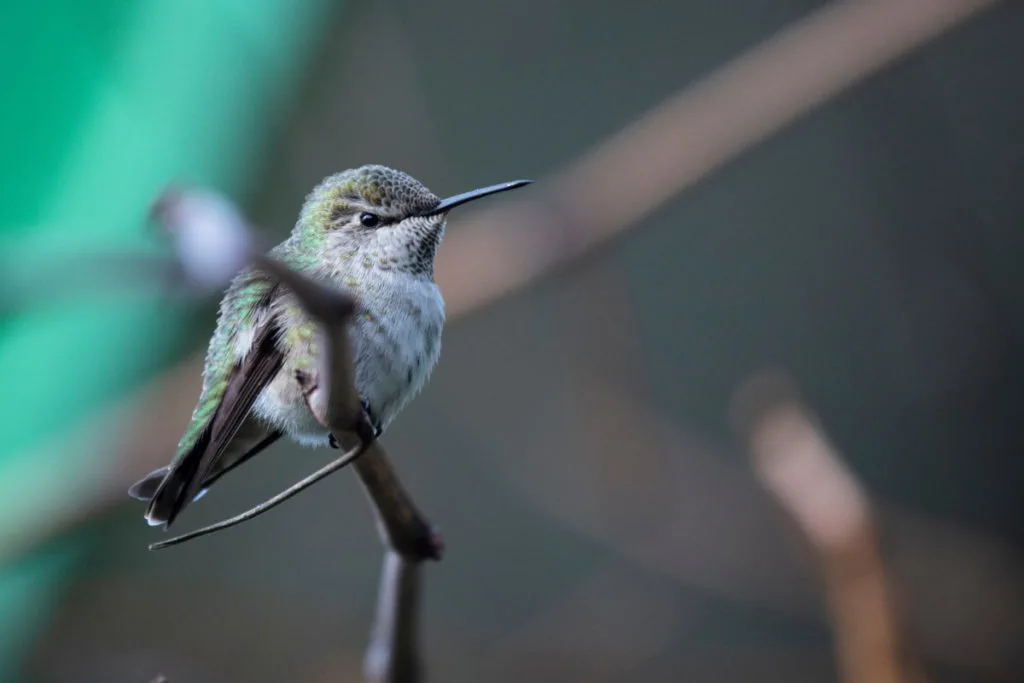
You’ve been warned.
Anyone who feeds these little South American visitors can tell you how amusing they are to have in their backyard. They’re also fiercely loyal, and once they’ve found a great place, they will return year after year.
Plus, these happy little birds are important pollinators.
When they stop at a flower, they pick up pollen on their heads and throats, which gets transferred to the next flower they visit. Some types of flowers have even developed specifically to be pollinated by hummingbirds; many of the tubular-shaped flowers these little birds enjoy sipping.
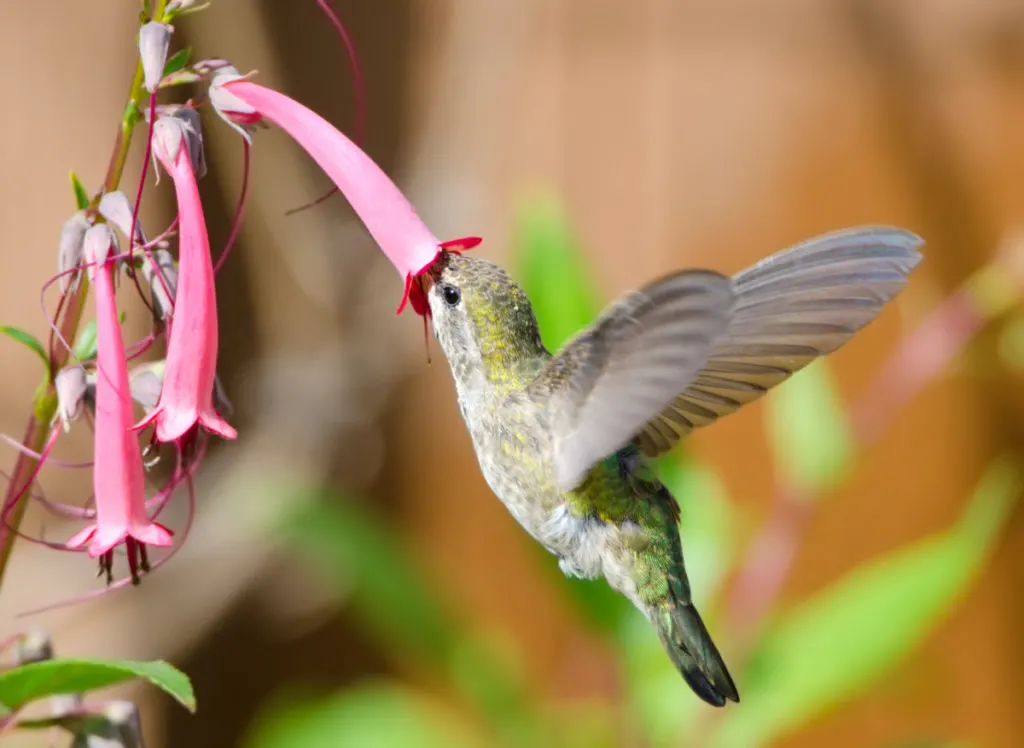
Let’s dive in, and I’ll walk you through everything you need to attract hummingbirds to your yard.
Flowers for Hummingbirds
As with all wild animals, hummingbirds are food-driven and will happily nest and stay where there is an abundant food supply.
For hummingbirds, the most important food source is nectar. They have a high metabolism, and they need a constant source of high-energy nectar. If you provide it, they will happily stick around.
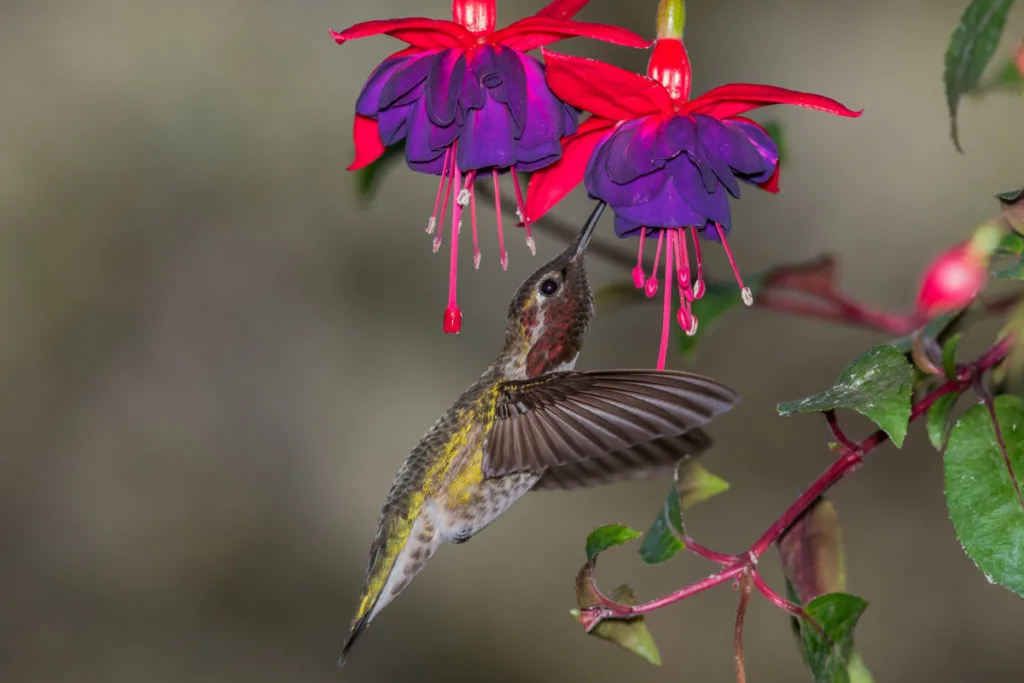
Naturally, hummingbirds get most of their nectar from the blooms of plants.
They’re specifically attracted to bright red, orange or pink flowers but will feed on any color flower. And they’re specifically attracted to tubular-shaped flowers, as these types of flowers often hold the most nectar in them.
Plant in Clumps
Like with other pollinators, the best way to attract hummingbirds is to plant clumps of brightly colored flowers together. They have keen eyesight, and planting bunches of the same flower together will draw their eye and invite them in for a closer look.
Plan Your Blooms
If you want to ensure you have a steady stream of hummingbirds in your backyard, plant flowers that bloom at different times during the growing season. If you plan accordingly and have flowers blooming in your yard from spring right through fall, you’ll keep the hummingbirds happy.
Deadhead
Another great way to keep your garden in constant bloom is to deadhead your flowers. Every day or two, take a stroll around your yard and garden and pinch off the wilted or dead blooms from your plants. Your plants will produce more flowers.
This is especially important to consider later in the season when you have more hummingbirds in the area (after the new ones have hatched) and when many flowers naturally start to taper off their blooming.
41 Hummingbird Approved Flowers and Vines
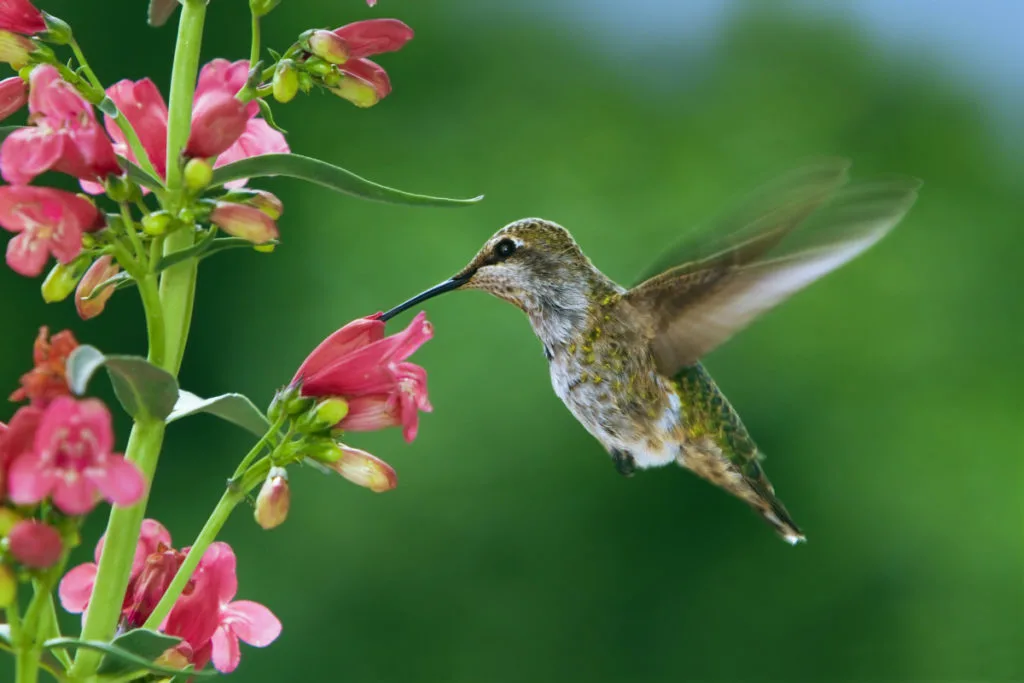
Here’s a list of flowers to get you started. If you want to plant flowers specifically to attract hummingbirds, be sure you talk to a local gardening expert, garden center staff, or your local extension office. All of these folks can suggest flowers based on when they bloom. And of course, if you can, try to include native species in your planning.
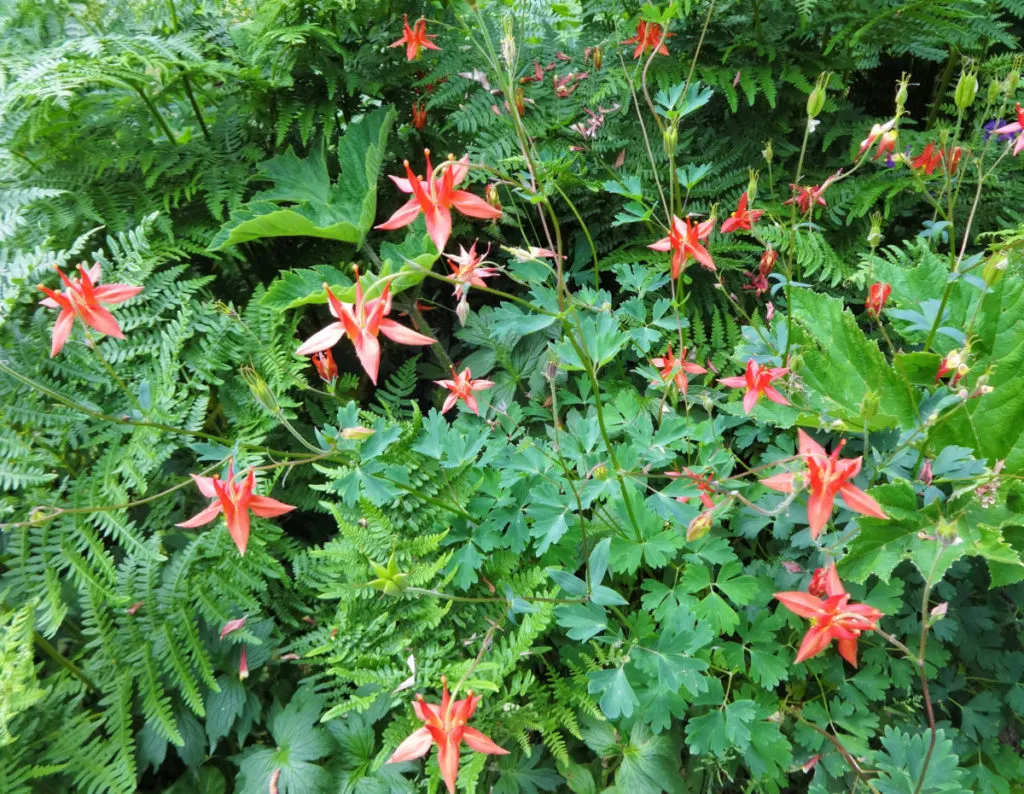
- Bergamot, bee balm
- Blazing star
- Bleeding heart
- Butterfly weed
- Cardinal flower
- Columbine
- Coral bells
- Dahlia
- Delphinium
- Fire pink
- Fireweed
- Four-o’clock
- Foxglove
- Fuchsia
- Geranium
- Gladiolus
- Hollyhock
- Hosta
- Impatiens
- Indian Pink
- Jewelweed (touch-me-not)
- Lily
- Lupine
- Morning Glory
- Nasturtium
- Painted cup (Indian paintbrush)
- Penstemon (beard-tongue)
- Petunia
- Phlox
- Scarlet runner bean
- Scarlet sage
- Snapdragon
- Solomon Seal
- Spider flower (cleome)
- Sweet William
- Trumpet creeper
- Trumpet honeysuckle
- Turk’s cap lily
- Verbena
- Virginia bluebell
- Zinnia
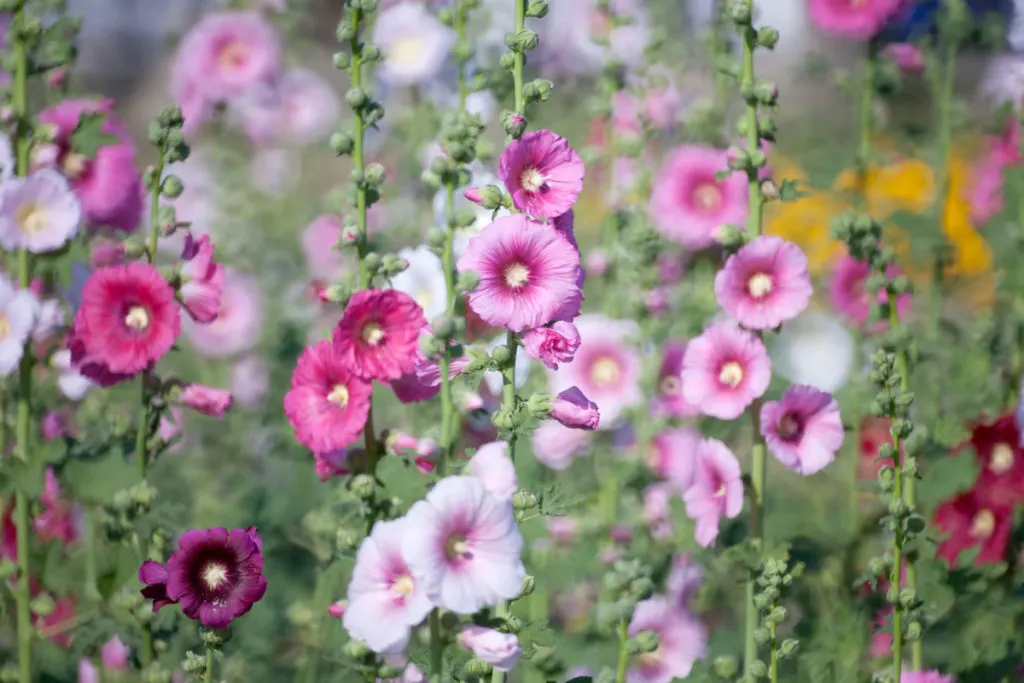
Hummingbird Feeders
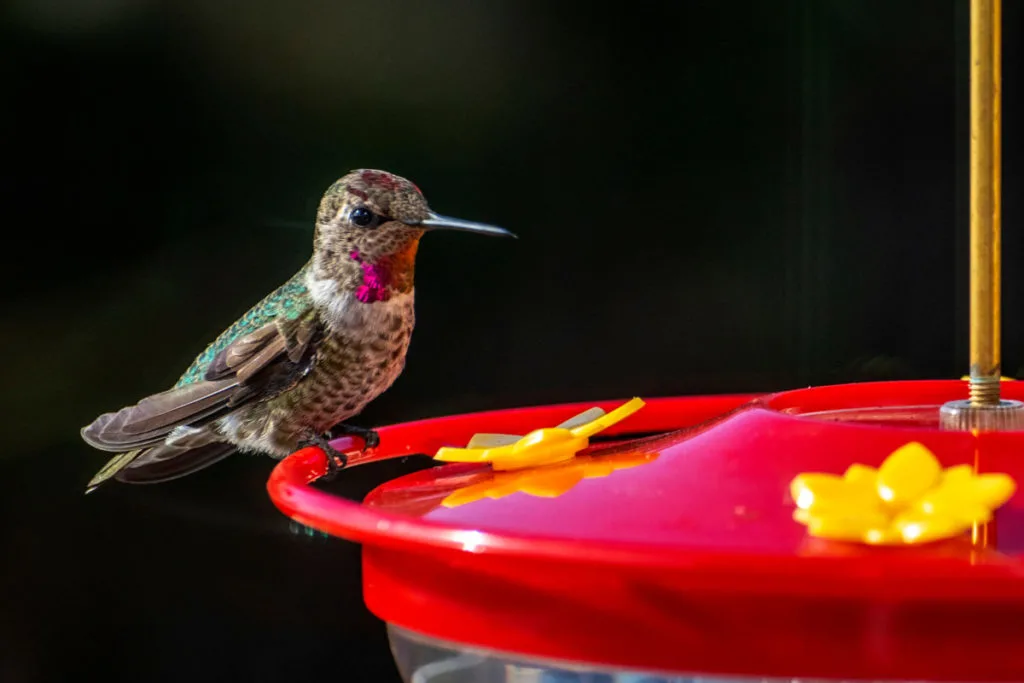
Another great way to provide food for hummingbirds is through the use of hummingbird feeders. Add a hummingbird feeder or two…or three…or four to your yard, and just watch what happens.
Initially, you should place new hummingbird feeders near brightly colored flowers to help attract the birds. Once they have found the feeder, you can slowly move it to a different location (such as closer to a window).
You should also strive to keep your feeders out of direct sun, as this will cause the nectar to spoil faster.
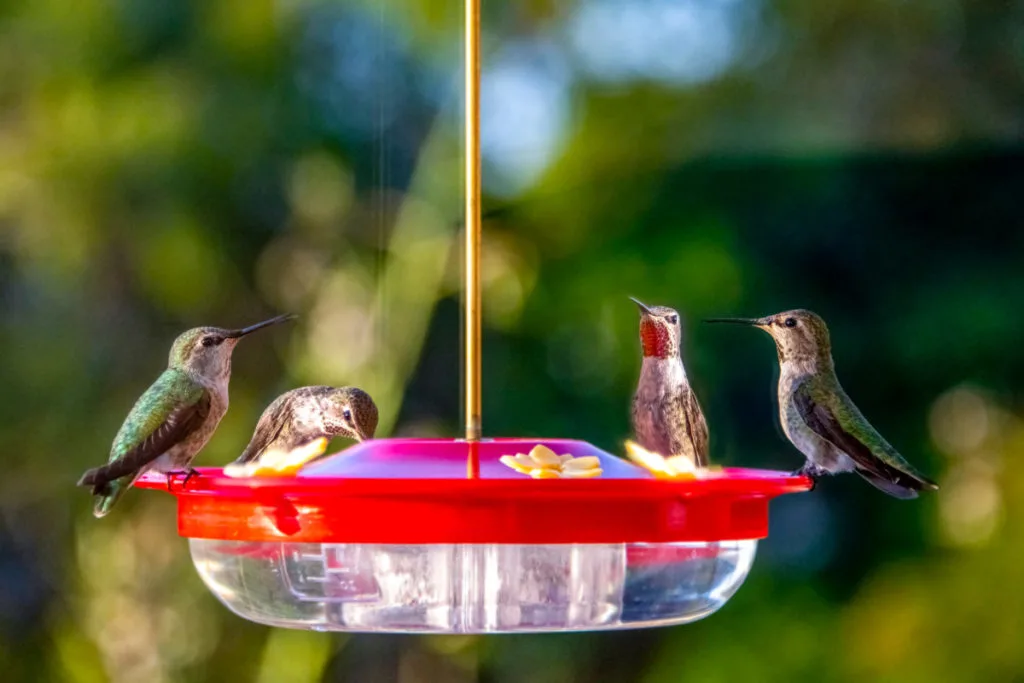
While there are plenty of hummingbird feeders on the market, most hummingbird experts agree that the saucer-style feeders with perches are the best set up. But as long as the feeder is predominantly red, has a perch, and has a clear reservoir so you can monitor how much nectar is left, nearly any design will attract hummingbirds.
And if you hate cleaning drowned ants out of your feeder reservoir, you may want to consider purchasing a couple of ant moats that will keep your nectar bug-free.
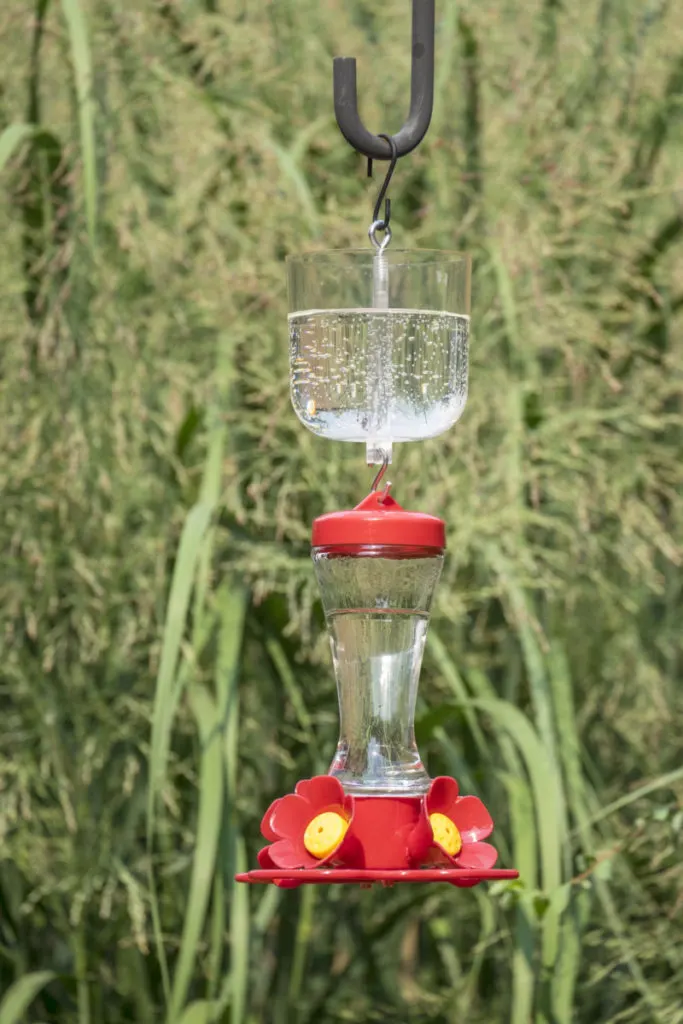
It’s important to provide fresh nectar consistently if you want hummingbirds to stick around. Luckily, you can make your own nectar.
Homemade Nectar Recipe
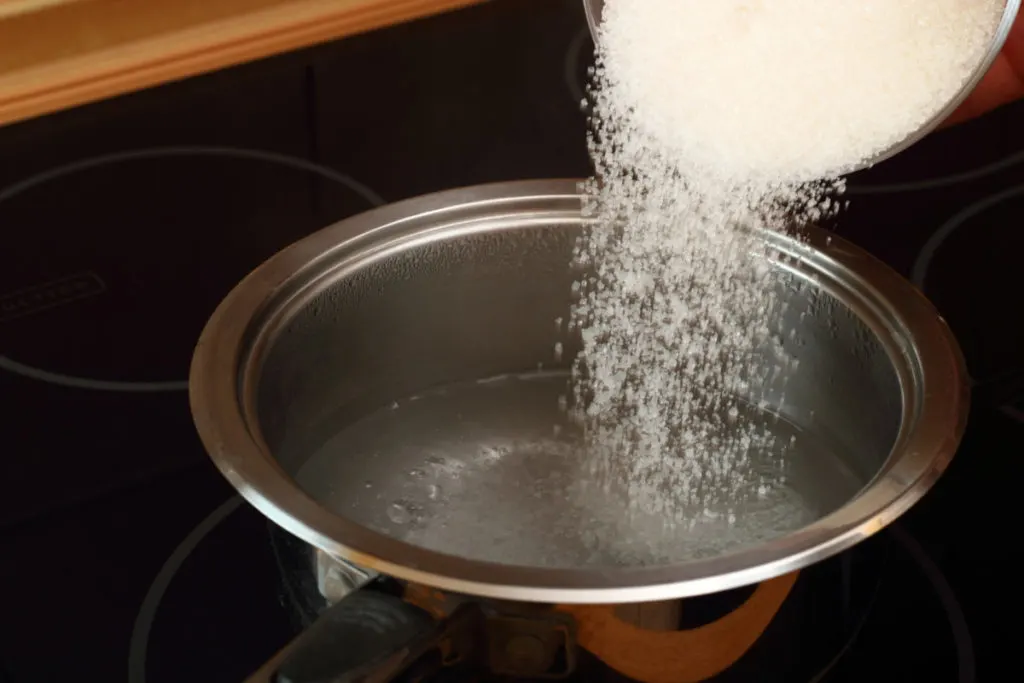
First and foremost, it’s important to note you should never add food coloring to your nectar. The dye is terrible for our little feathered friends and can cause serious harm. If you choose to purchase nectar, the same applies; never buy nectar with food coloring in it.
Of course, making homemade nectar is so simple, you won’t even want to make the trip to the garden center to buy the ready-made stuff.
It’s as simple as 4:1 – four cups of water for every one cup of sugar.
And depending on how many feeders you have set up, you may need to double, even triple, this ratio.
Add the sugar to the water and bring the mixture to a boil, stirring until the sugar is completely dissolved. Boil the water for a couple of minutes and then let the nectar cool to room temperature before using it.
You can store your nectar in the fridge for a week.
Clean and Replace Nectar Regularly
It’s important to clean your feeders regularly and refill them with fresh nectar once a week. The good part about feeding hummingbirds is that once they find your feeder, you’ll rarely have to replace stagnant nectar.
My sweetie has four hummingbird feeders, and come high-summer, he is filling them every day and making a new batch of fresh nectar nearly every other day.
Make Sure Bugs Are on the Menu
Hummingbirds don’t live on nectar alone; in fact, an important part of their diet is protein which they get through insects and larvae.
If you want to create a hummingbird haven in your backyard, it’s important to ditch the pesticides. Don’t worry; the hummingbirds will help to keep the bugs at bay.
Spiders are a big part of hummingbirds’ insect diet. And not only do they eat the spiders, but they use their webs when constructing nests. Leave the spiders where you find them, and the hummingbirds will do the rest.
Another great way to help your hummers get the protein they need is to hang a hummingbird bug feeder near your nectar feeder. These handy little feeders have a reservoir where you place a banana peel to attract bugs.
Perching and Nesting
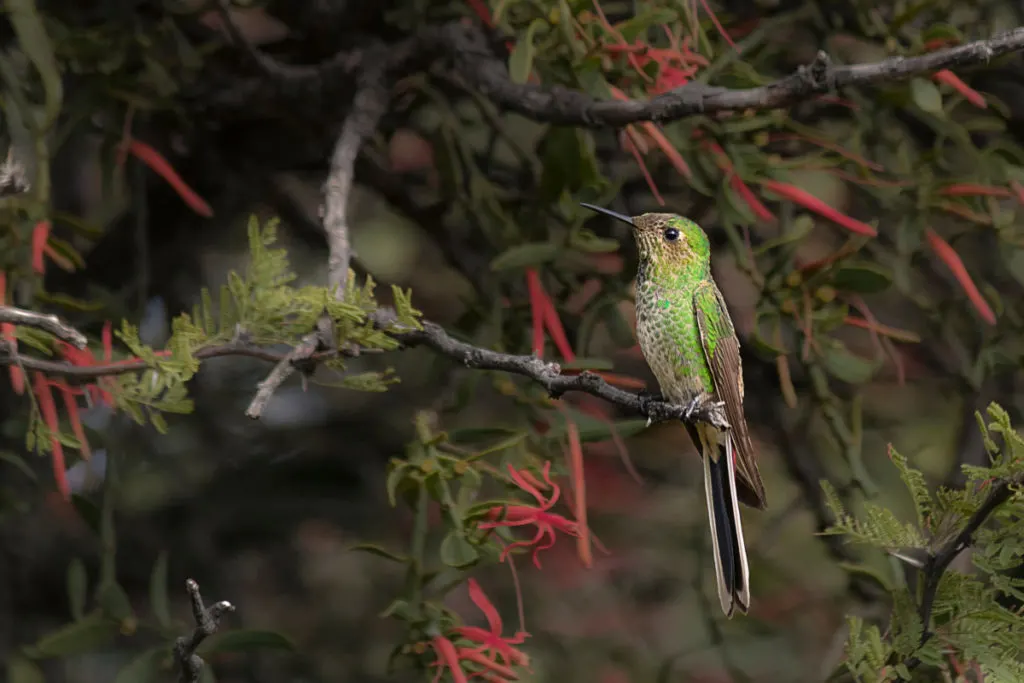
Hummingbirds love a good perch. I would too, after beating my little wings that fast. They like to snooze in the shade of the inner branches of a shrub. Or sometimes they like to survey their empire from a clearly visible branch, like tiny little tyrants. This is why it’s important to provide natural perches if you want to attract hummingbirds.
Place hummingbird feeders near shrubs or trees where the birds can safely flit for a rest. If you want to turn your backyard into a hummingbird hangout, you might want to plant a few small bushes or trees for just such a purpose – bonus if it’s a flowering tree or shrub.
A few shrubs and trees that are popular with hummingbirds are:
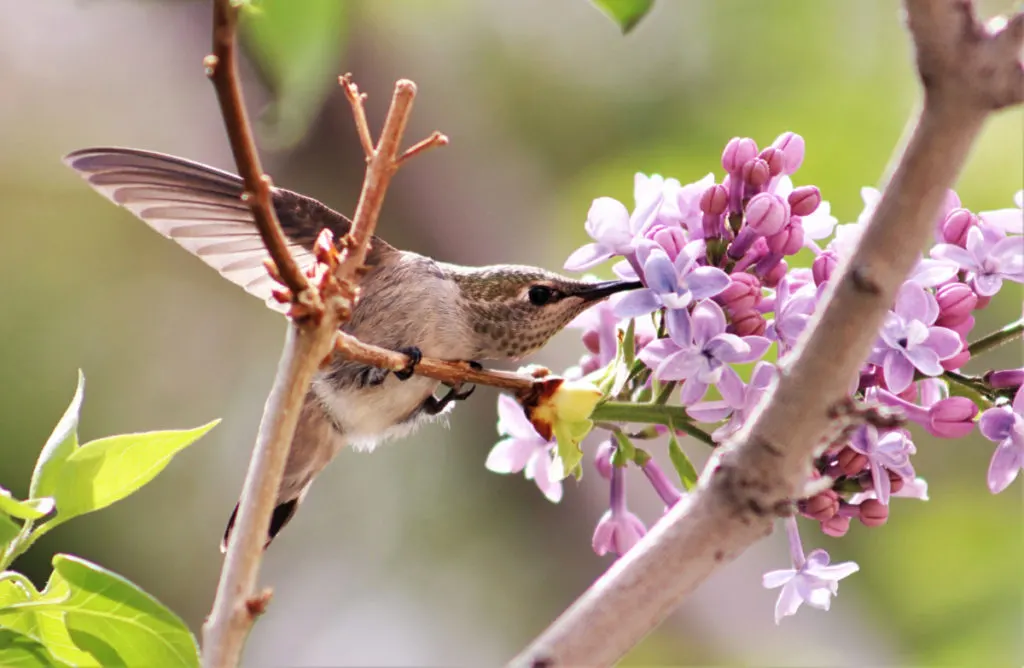
- Azalea
- Coralberry
- Lilac
- Weigela
- Apple
- Eastern Redbud
- Flowering crabapple
- Hawthorn
- Horse chestnut
- Northern catalpa
- Tulip poplar
Hummingbirds will nest in these trees and shrubs too. The females will build nests high off the ground, under the canopy of overhead branches. You may find a nest once the leaves have fallen and cold weather hits. Leave nests where you find them, and the females will reuse them next year.
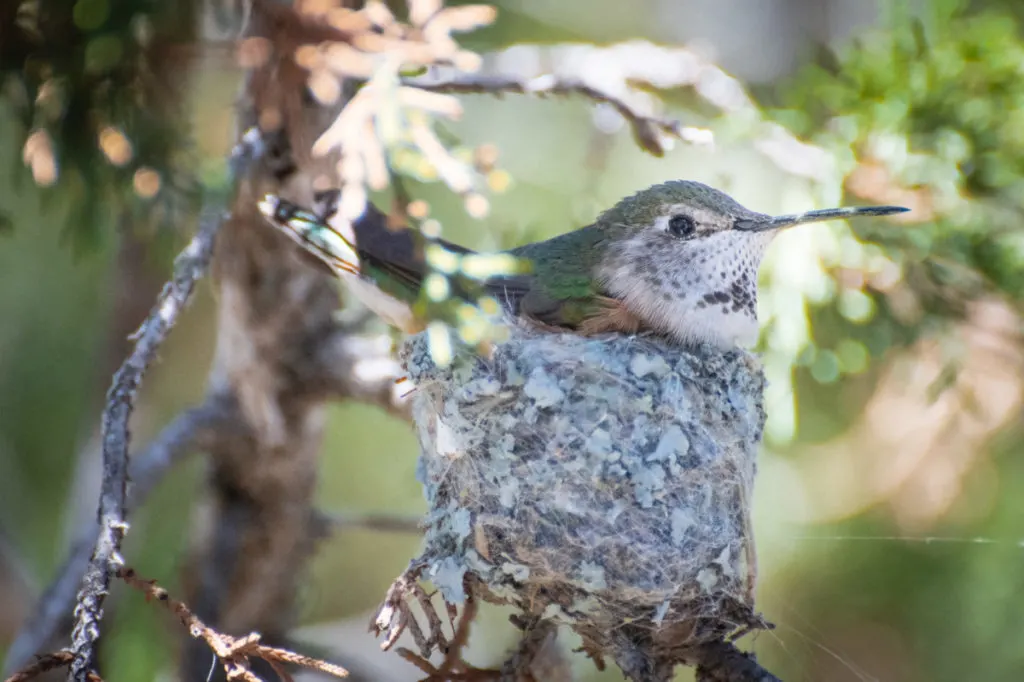
Don’t Forget the Water
Like any living creature, hummingbirds appreciate a source of water, although not necessarily for drinking. Hummingbirds naturally stay hydrated through all of the nectar they sip throughout the day.
Hummingbirds love a fine mist spray, maybe more than dogs love being sprayed with a hose.
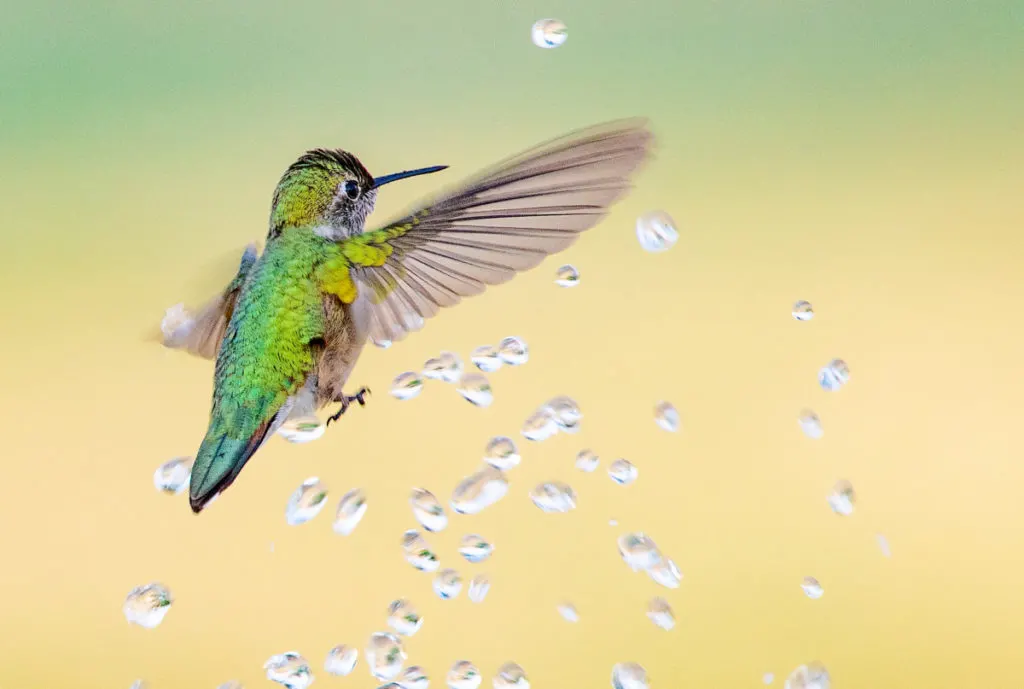
These little birds get downright silly when it comes to flying through a mister. They will zip in and out until they’re completely water-logged before landing on a branch to dry. Set up a fine mist sprayer near a feeder or a tree where you can enjoy the show. Your feathered friends will thank you for it.
Tips and Tricks for Keeping Hummingbirds Happy
And that’s about all there is to it. Like most of us, they just want a good meal, a place to take a nap, and a refreshing shower. Here are a few more things to consider when you’re working towards your hummingbird whisperer status.
When Can I Expect Hummingbirds to Visit?
Probably one of the first tips we should talk about is when hummingbirds arrive on the scene in your neighborhood. Hummingbirds are migratory and (wisely) spend their winters down in South America and Mexico. It’s only when the weather begins to warm that they find their way back up to the United States.
Hummingbirds travel with the flowers. As early-blooming flowers begin to blossom, you will find these tiny flying jewels in your area.
A general rule-of-thumb to follow is to expect hummingbirds to show up in the southern states in late March and then make their way up to the mid-states around mid-April or early May, finally making their way up to the northern-most states by May to mid-May.
Keep an eye on the springtime blooms in your area. When you begin seeing tubular-shaped blooms opening, it’s time to put your feeders out.
When Do They Head Home?
Hummingbirds will happily spend the summer with you until they’re ready to head back to South America for the winter. For those northern states, this means you’ll have visitors through September before they begin migrating south again. Middle states can expect their visitors to taper off in October and further south around November.
Ribbons and Bows
Hummingbirds are pretty loyal, and once they’ve found a place with reliable food, water, and shelter, they will return year after year. However, if you’re just getting started, you may find it hard to get them to notice your feeder, especially if you don’t have flowers planted.
Make your yard easy to spot from above by tying bright red or orange ribbons on trees and bushes or your hummingbird feeders. Once word gets out that you’ve got feeders in your yard, you can remove the ribbons.
Territorial Tyrants
My sweetie and I will sit out on the back deck for hours at his place, watching the aerial stunts, petty fights, and territorial displays that go on. It’s a bit like sitting in the middle of a miniature aerial dog fight.
They get pretty crazy.
Hummingbirds are incredibly territorial. If you notice any little feathered bullies emerging, it’s time to put up another feeder somewhere else on your property.
Keep an Extra Feeder in Reserve
These little birds can end up acting like tiny flying pigs. If a feeder is missing while you clean it, you will hear about it from the peanut gallery. Purchase an extra feeder to keep in reserve while you clean others.
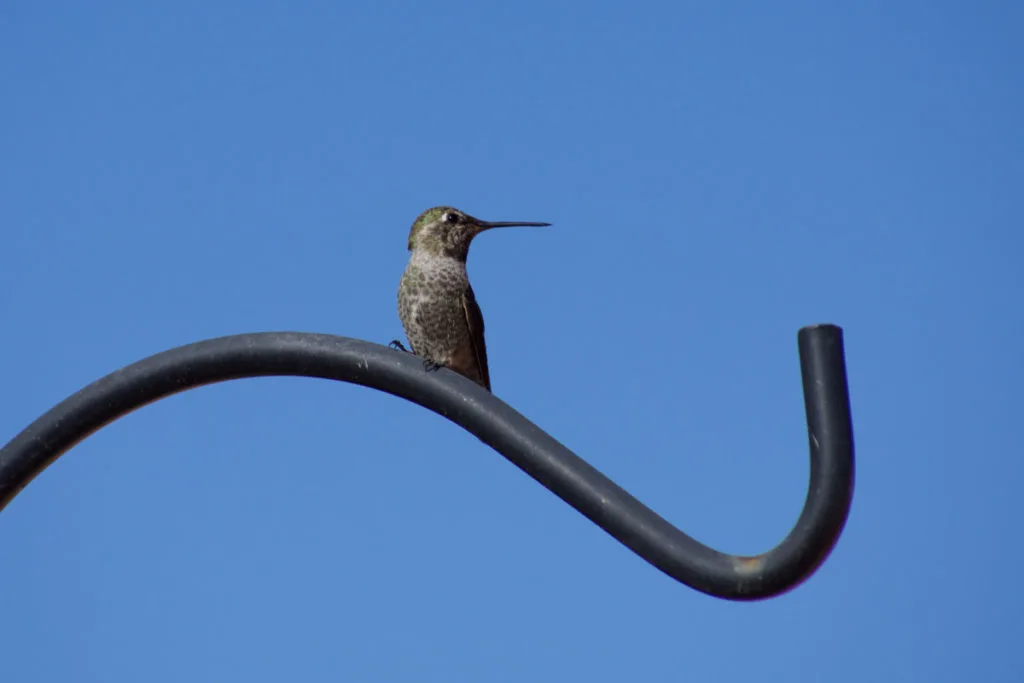
Many folks run their feeders through the dishwasher, so having an extra feeder to put out with fresh nectar while your other one is being washed keeps your hummers happy.
The Super Cool Hummingbird Whisperer Ring
And of course, last but not least, that cool membership ring I told you about.
If you have feeders near your house, especially near a patio, you’ll be amazed at how comfortable the hummingbirds will become around you. Many folks enjoy hand-feeding hummingbirds too.
Get yourself a nifty hummingbird ring feeder and sit patiently. Before you know it, you’ll have an up-close and personal visitor. (You can also use a red soda bottle cap.)
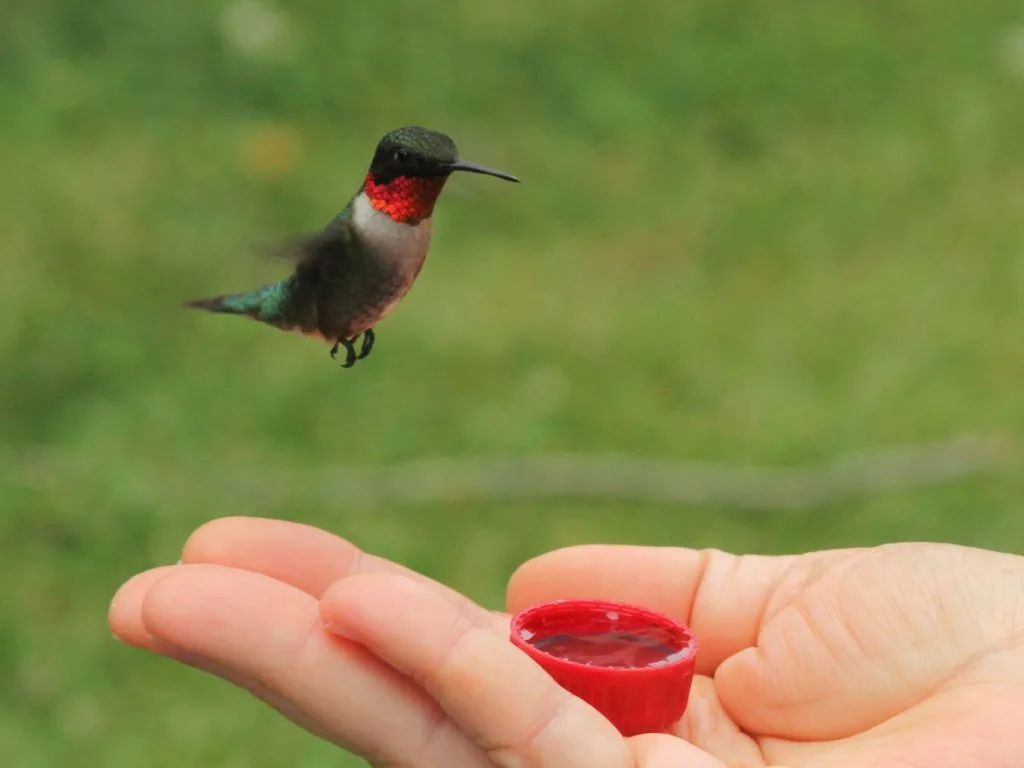
As we close, I’d like to take a moment to remind you that Rural Sprout accepts no responsibility should you find yourself with seventeen hummingbird feeders in your backyard and hundreds of these amazing little birds demanding more nectar. They really are one of the more fun birds to attract to your yard, and we hope you’ll agree.
Don’t stop with hummingbirds, here’s a list of flowers and trees to attract other beautiful birds to your yard.
